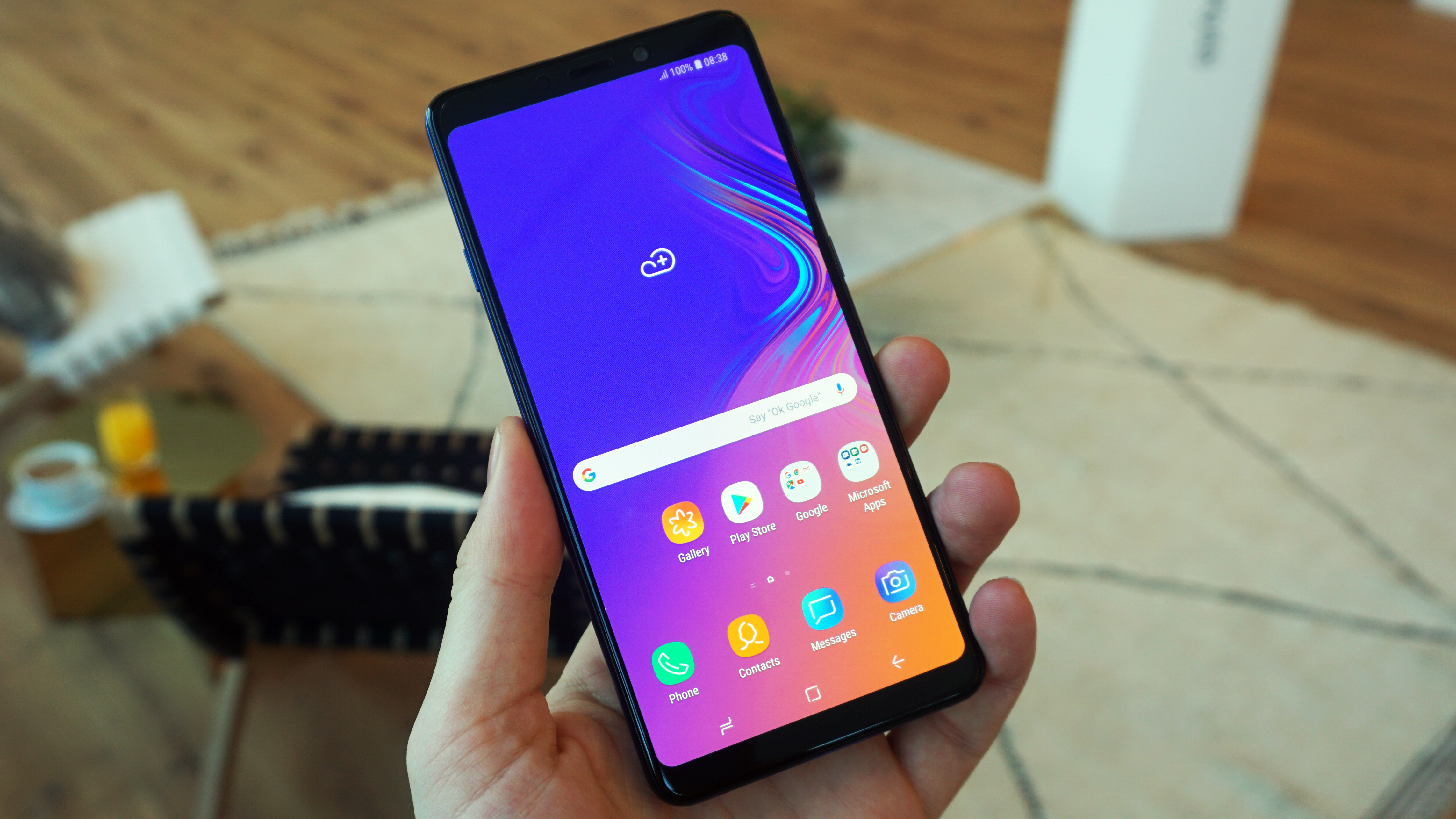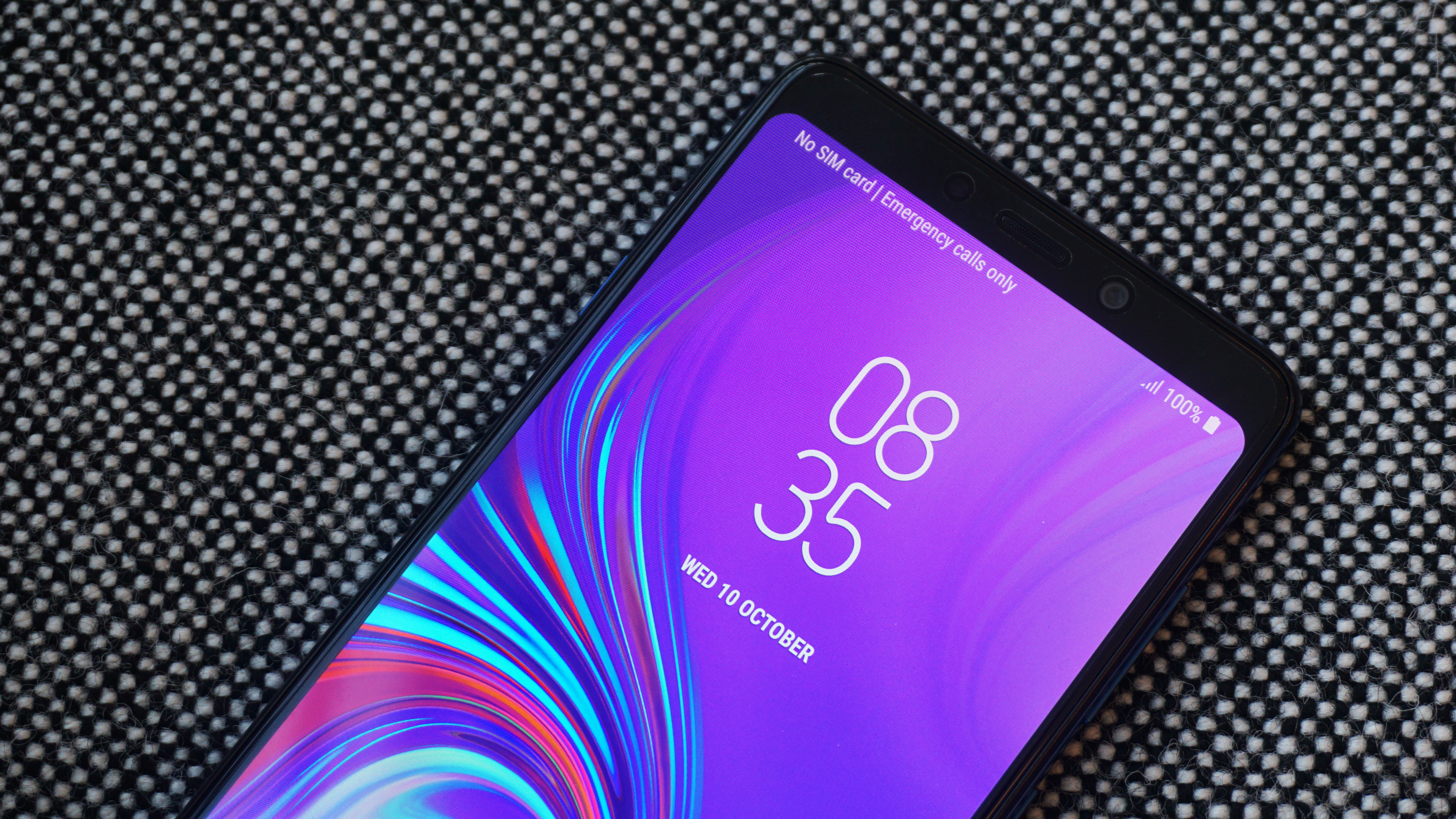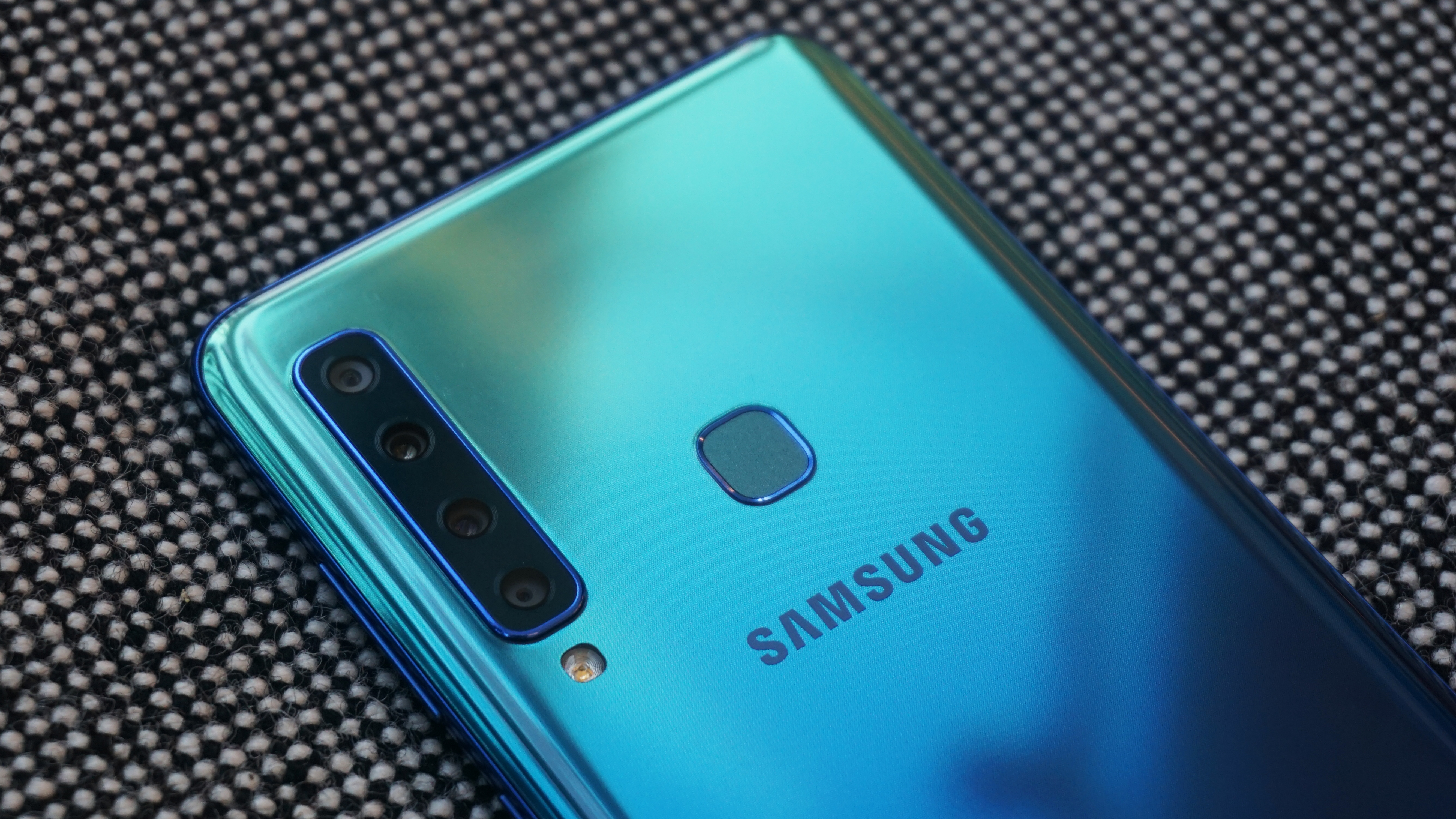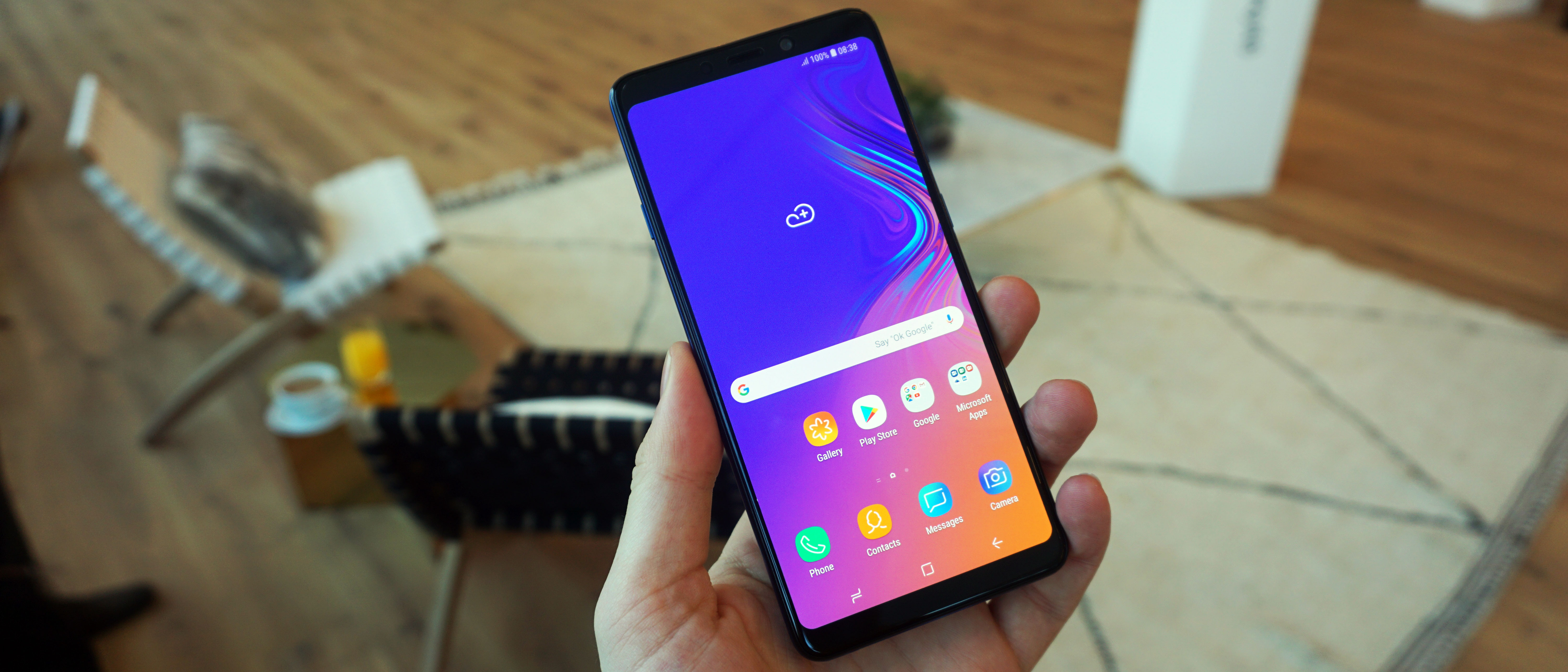Early Verdict
The Samsung Galaxy A9 is a good looking, feature packed smartphone with standout camera spec.
Pros
- +
Impressive quad-cam setup
- +
Large, bright, colorful display
Cons
- -
No wireless charging
- -
Runs the older Android Oreo
Why you can trust TechRadar
The Samsung Galaxy A9 (2018) has four rear cameras. Yes, you read that right, four. It's a world's first, and while it may seem excessive Samsung believes the additional hardware makes for better photos.
Samsung goes as far as to say the Galaxy A9 is 'optimized for Instagram', which gives you a clear indication at who this handset is aimed at. Young adults where camera experience is king and social media is a daily ritual.
Unsurprisingly, the main focus of the Samsung Galaxy A9 is its quad-cam setup round the back, but with a 6.3-inch Full HD+ display, 6GB of RAM, 128GB of storage (plus microSD slot) and a 3,800mAh battery it offers up a decent array of specs.
It sits atop Samsung's mid-range A series of devices, sliding in just under the flagship Galaxy S line - offering some top-end features at a more attractive price point.
This means the new Samsung Galaxy A9 has the likes of the OnePlus 6T and Honor View 20 to contend with in an increasingly competitive 'affordable flagship' segment.
While the Samsung Galaxy A9 is now available to buy, we're still waiting on our review device. Once it arrives, we'll get to work putting it through our in-depth review process.
Samsung Galaxy A9 (2018) release date and price
The Samsung Galaxy A9 is available in the UK both SIM free and on a range of contracts.
Sign up for breaking news, reviews, opinion, top tech deals, and more.
The Samsung Galaxy A9 price is £449 (around $580, AU$800) SIM free, making it around the same price as the the Honor View 20 and OnePlus 6T, and comfortably cheaper than the Samsung Galaxy S9.

Design
The Samsung Galaxy A9 has a premium design with a metal frame and a glass front and rear, insuring the handset looks and feels the part.
It's available in three colors, with the most eye-catching options being lemonade blue and bubblegum pink, which boast attractive two-tone hues which are reminiscent of the fancier finishes on the Huawei P20 and P20 Pro.
For those who want their phone to be a little more understated, the Samsung Galaxy A9 is also available in caviar black.
Measuring 162.5 x 77 x 7.8mm, the Samsung Galaxy A9 is a sizable handsets - thanks in part to the 6.3-inch display - which makes slightly taller and wider than the Samsung Galaxy Note 9.
It's lighter than the firm's supersized phablet though, weighing in at 183g. It means that while there's no getting away from the fact that this is a big phone in the hand, it doesn't feel overbearing.
The glass back doesn't provide much grip however, so one handed use feels a little precarious (a case may be required for peace of mind), plus it's a fingerprint magnet.
We had to wipe the rear numerous times during our hands on preview of the Galaxy A9 so get clean pictures for you.
The rear mounted fingerprint scanner falls nicely under forefinger, while the power/lock and volume keys on the right can be hit relatively easily is you've got larger hands.
Samsung Galaxy A9 (2018) hands on gallery










Flip to the left side of the Samsung Galaxy A9 and there's another physical button - Samsung's Bixby button.
This key launches the firm's smart voice assistant, and while it may not be to everyone's taste, its inclusion in a non-flagship device is another example of Samsung filtering down its top-tier tech.
There's good news for audiophiles on the base of the Samsung Galaxy A9, as a headphone jack resides alongside a USB-C port and single, down-firing speaker.
Display
The Samsung Galaxy A9 (2018) packs a 6.3-inch Super AMOLED Full HD+ display which is bright, clear and colorful.
While the 1080 x 2220 resolution isn't as impressive as the QHD panels on the Galaxy S9, S9 Plus and Note 9, for its price point it's hard to knock the Full HD+ offering on the Galaxy A9.
You can see the design language of Samsung's flagship infinity display spilling over to the Galaxy A9, but it's not quite as edge-to-edge here, with slightly thicker boarders all the way around the device.
That's to be expected considering the Samsung Galaxy A9's price point, and there's still plenty of screen to enjoy here - and no notch, which may please some users.

Camera
We've already mentioned it, and there is no denying that this is the main draw for the Samsung Galaxy A9 - the quad-cam offering on the rear of the handset.
The primary camera is a 24MP offering which is the default option in auto mode, and the one which will give you best low light performance.
Next up is an 8MP, 120 degree wide angle lens allowing you to get more into each shot, followed by a 5MP depth-sensing camera which collects data used in Samsung's Live Focus background blur mode.
Finally there's a 10MP telephoto lens providing a 2x optical zoom over the primary camera, allowing you to get closer to the action.
Up until now some of these features have been provided by software, but Samsung claims the move to hardware will garner better results. Meanwhile, round the front there's a 24MP selfie camera with its own.

During our brief time with the Samsung Galaxy A9 we found the primary camera was generally good, but if you zoom into shots after taking them the detail gets muddy pretty easily.
It's worth noting that the Galaxy A9 we got our hands on wasn't running final camera software, so image quality may improve before the handset officially goes on sale.
There are plenty of options in the camera app too, but Auto mode will likely be the most used mode.
You'll need to select the Live Focus mode to shoot Bokeh, background blurred, images on the Galaxy A9, which uses the 24MP primary and 5MP depth sensing cameras.
However, you can switch between the primary, zoom and wide-angle cameras easily from auto mode. A small, on-screen prompt appears in the viewfinder area, allowing you to tap between the three options, getting you closer to the action or expanding the field of view to fit more in.

Battery and performance
The Samsung Galaxy A9 comes with an octa-core Exynos 7885 chipset and 6GB of RAM which provides a decent slug of power.
It's in charge of running Android 8 Oreo, which is sadly not the latest version of Google's mobile software. Samsung tells us that it will bring the Android 9 Pie update to the Galaxy A9 as soon as it's can, but it's still working on adapting the platform with its own interface.
While not date was given for the Android Pie update, we don't expect it to land on the Galaxy A9 until early next year.
Android does run smoothly on the Galaxy A9, and we experienced slick performance and fast app load times during our time with the handset.
There's good news in terms of storage, with the Samsung Galaxy A9 coming with a sizable 128GB of space built-in. If that's not enough space (although for most it will be) there's also a microSD slot which supports cards up to 512GB in size.
The Samsung Galaxy A9 also fits in a 3,800mAh battery which is bigger than the power packs squeezed into the Galaxy S9 and Galaxy S9 Plus.
The hope is the Galaxy A9 will offer up some impressive battery life, but you'll have to wait for our full review to find out just how well it performs.
There isn't any wireless charging included here, but the Samsung Galaxy A9 does support fast charging, allowing you to quickly top up the battery if you are running low.

Early verdict
The Samsung Galaxy A9 is a good looking, feature packed smartphone with standout camera spec. Whether that camera spec lives up to Samsung's hype remains to be seen - keep an eye out for our in-depth review - but the early signs are positive.
- Visit our Samsung coupon page for our latest deals and discounts.

TechRadar's former Global Managing Editor, John has been a technology journalist for more than a decade, and over the years has built up a vast knowledge of the tech industry. He’s interviewed CEOs from some of the world’s biggest tech firms, visited their HQs, and appeared on live TV and radio, including Sky News, BBC News, BBC World News, Al Jazeera, LBC, and BBC Radio 4.
What is a hands on review?
Hands on reviews' are a journalist's first impressions of a piece of kit based on spending some time with it. It may be just a few moments, or a few hours. The important thing is we have been able to play with it ourselves and can give you some sense of what it's like to use, even if it's only an embryonic view. For more information, see TechRadar's Reviews Guarantee.
